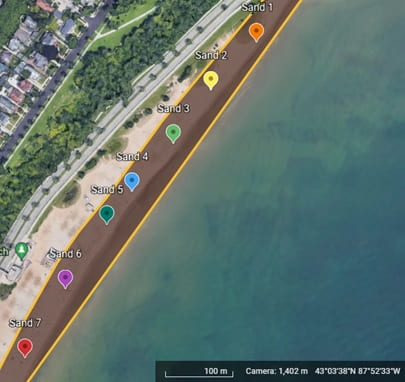The Artificial Intelligence / Machine Learning (AI/ML) methods used for the study of surfaces and interfaces in Triboinformatics can be applied to diverse sets of objects.
One current project is an investigation of bacterial contamination of beach sand in Milwaukee based on samples from the Bradford Beach on the shore of lake Michigan in Milwaukee. Physicochemical and wetting properties of sand influence the survival and proliferation of Escherichia coli (E. coli) in beach sand, which is directly related to public health risk. In our study, we predict E. coli concentration using some surface properties including the zeta-potential, moisture content, pore radius, and wetting. Five ML regression models are used including the Artificial Neural Network (ANN), Support Vector Machine (SVM), Gradient Boosting Machine (GBM), Random Forest (RF), and k-Nearest Neighbors (KNN) for this. In the data-driven analysis, the state of sand, processing temperature, and the contact angle presenting the wettability of the sand are identified as the most crucial parameters in predicting E. coli concentration.
The new paper is in preparation:
MS Hasan, A Nunez, M Nosonovsky, MR Silva 2023, “Prediction of E. coli concentration from wetting properties of beach sand using machine learning models” Surface Innovations https://doi.org/10.1680/jsuin.22.01087

Aeral view of the Bradford Beach in Milwaukee with locations of sample intake marked.
Another potential application is wine quality analysis. Wine is the one of the oldest products in human culture, which has many types and varieties. The evaluation of wine quality is one of the most difficult tasks in accesing the quality of food products, and is usually carried out by professional tasters (sommeliers) organoleptically using special terminology for describing visual, aromatic and gustatory impressions (the “wine language”). The science of wine is called oenology.
The chemistry of wine is complicated. AI/ML methods can be used for finding new ways to conduct otherwise complicated analyses such as mean degree of polymerization of polyphenolics (tannins), concentrations of cis/trans-oak lactones in wine, and similar by finding correlations with other parameters. A system based on Artificial Neural Network (ANN) algorithms for assessing the quality of wine based on experimentally obtained descriptors of the chemical properties of wine, can quantify the quality of wine on a scale from “1” to “10″ trained on a database of several thousand 5000 samples (conducted by my colleague Dr. Shityakov). It is proposed to link the descriptors with the terminology of the organoleptic analysis of wine drinks. As a result, it may become possible to demonstrate the possibility of using AI for automatic analysis (tasting) of wine.